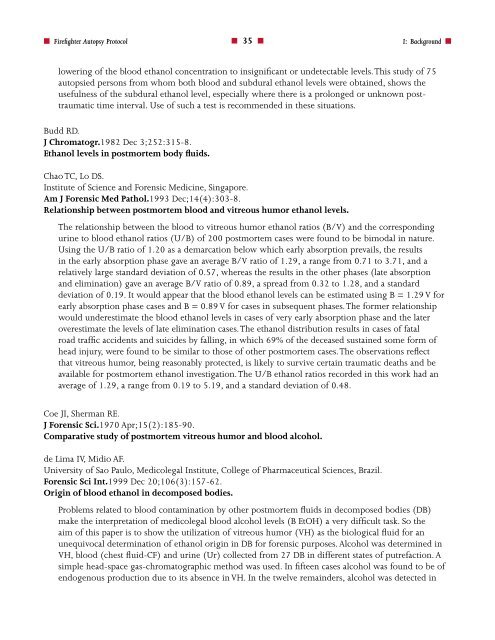Firefighter Autopsy Protocol - US Fire Administration - Federal ...
Firefighter Autopsy Protocol - US Fire Administration - Federal ...
Firefighter Autopsy Protocol - US Fire Administration - Federal ...
Create successful ePaper yourself
Turn your PDF publications into a flip-book with our unique Google optimized e-Paper software.
■ <strong><strong>Fire</strong>fighter</strong> <strong>Autopsy</strong> <strong>Protocol</strong><br />
■ 35 ■<br />
I: Background ■<br />
lowering of the blood ethanol concentration to insignificant or undetectable levels. This study of 75<br />
autopsied persons from whom both blood and subdural ethanol levels were obtained, shows the<br />
usefulness of the subdural ethanol level, especially where there is a prolonged or unknown posttraumatic<br />
time interval. Use of such a test is recommended in these situations.<br />
Budd RD.<br />
J Chromatogr.1982 Dec 3;252:315-8.<br />
Ethanol levels in postmortem body fluids.<br />
Chao TC, Lo DS.<br />
Institute of Science and Forensic Medicine, Singapore.<br />
Am J Forensic Med Pathol.1993 Dec;14(4):303-8.<br />
Relationship between postmortem blood and vitreous humor ethanol levels.<br />
The relationship between the blood to vitreous humor ethanol ratios (B/V) and the corresponding<br />
urine to blood ethanol ratios (U/B) of 200 postmortem cases were found to be bimodal in nature.<br />
Using the U/B ratio of 1.20 as a demarcation below which early absorption prevails, the results<br />
in the early absorption phase gave an average B/V ratio of 1.29, a range from 0.71 to 3.71, and a<br />
relatively large standard deviation of 0.57, whereas the results in the other phases (late absorption<br />
and elimination) gave an average B/V ratio of 0.89, a spread from 0.32 to 1.28, and a standard<br />
deviation of 0.19. It would appear that the blood ethanol levels can be estimated using B = 1.29 V for<br />
early absorption phase cases and B = 0.89 V for cases in subsequent phases. The former relationship<br />
would underestimate the blood ethanol levels in cases of very early absorption phase and the later<br />
overestimate the levels of late elimination cases. The ethanol distribution results in cases of fatal<br />
road traffic accidents and suicides by falling, in which 69% of the deceased sustained some form of<br />
head injury, were found to be similar to those of other postmortem cases. The observations reflect<br />
that vitreous humor, being reasonably protected, is likely to survive certain traumatic deaths and be<br />
available for postmortem ethanol investigation. The U/B ethanol ratios recorded in this work had an<br />
average of 1.29, a range from 0.19 to 5.19, and a standard deviation of 0.48.<br />
Coe JI, Sherman RE.<br />
J Forensic Sci.1970 Apr;15(2):185-90.<br />
Comparative study of postmortem vitreous humor and blood alcohol.<br />
de Lima IV, Midio AF.<br />
University of Sao Paulo, Medicolegal Institute, College of Pharmaceutical Sciences, Brazil.<br />
Forensic Sci Int.1999 Dec 20;106(3):157-62.<br />
Origin of blood ethanol in decomposed bodies.<br />
Problems related to blood contamination by other postmortem fluids in decomposed bodies (DB)<br />
make the interpretation of medicolegal blood alcohol levels (B EtOH) a very difficult task. So the<br />
aim of this paper is to show the utilization of vitreous humor (VH) as the biological fluid for an<br />
unequivocal determination of ethanol origin in DB for forensic purposes. Alcohol was determined in<br />
VH, blood (chest fluid-CF) and urine (Ur) collected from 27 DB in different states of putrefaction. A<br />
simple head-space gas-chromatographic method was used. In fifteen cases alcohol was found to be of<br />
endogenous production due to its absence in VH. In the twelve remainders, alcohol was detected in
















